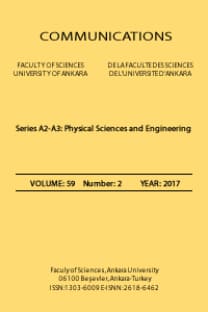LPI RADAR WAVEFORM CLASSIFICATION USING BINARY SVM AND MULTI-CLASS SVM BASED ON PRINCIPAL COMPONENTS OF TFI
low probability of intercept radar, support vector machine, principal component analysis
___
Pace, P.E., Detecting and Classifying Low Probability of Intercept Radar. 2nd Ed., Artech House, Norwood, MA, USA, 2009.Tao, R., Li, B., Sun, H., Research Progress of the Algebraic and Geometric Signal Processing, Defence Technology, 9(1) (2013), 40-47.
Kong, S.H., Kim, M., Hoang, L.M., Kim, E., Automatic LPI Radar Waveform Recognition Using CNN, IEEE Access, 6 (2018), 4207-4219.
Hoang, L.M., Kim, M., Kong, S.H., Automatic Recognition of General LPI Radar Waveform Using SSD and Supplementary Classifier, IEEE Transactions on Signal Processing, 67(13) 2019, 3516-3530.
Gao, L., Zhang, X., Gao, J., You, S., Fusion Image Based Radar Signal Feature Extraction and Modulation Recognition, Access IEEE, 7 (2019), 13135-13148.
Huang, Z., Ma, Z., Huang, G., Radar Waveform Recognition Based on Multiple Autocorrelation Images, Access IEEE, 7 (2019), 98653-98668.
Gulum, T., Autonomous Non-Linear Classification of LPI Radar Signal Modulations, https://calhoun.nps.edu/handle/10945/3302; 2007 [accessed 24 September 2019].
Kishore, T.R., Rao, K.D., Automatic intrapulse modulation classification of advanced LPI radar waveforms, IEEE Trans. Aerosp. Electron. Syst., 53(2) (2017), 901-914.
Tong, X., Modelling and realization of real time electronic countermeasure simulation system based on SystemVue, Defence Technology, 2019.
Deng, B., Luan, J., Cui, S., Analysis of parameter estimation using the sampling-type algorithm of discrete fractional Fourier transform, Defence Technology, 10(4) (2014), 321-327.
Liu, M., Liao, G., Yang, Z., Song, H., Gong, F., Electromagnetic Signal Classification Based on Deep Sparse Capsule Networks, Access IEEE, 7 (2019), 83974-83983.
Zeng, X., Wang, S., Bark-wavelet Analysis and Hilbert–Huang Transform for Underwater Target Recognition, Defence Technology, 9(2) (2013), 115-120.
Choi, H.I., Williams, W.J., Improved time-frequency representation of multicomponent signals using exponential kernels, IEEE Trans. Acoust., Speech, Signal Process., 37(6) (1989), 862-871.
Hollinger, K.B., Code optimization for the Choi-Williams distribution for ELINT applications, https://calhoun.nps.edu/handle/10945/4422; 2009 [accessed 24 September 2019].
Liu, Y., Xiao, P., Wu, H., Xiao, W., LPI radar signal detection based on radial integration of Choi-Williams time-frequency image, Journal of Systems Engineering and Electronics, (2015), 973-981.
Hastie, T., Tibshirani, R., Friedman, J., The Elements of Statistical Learning, 2nd Ed., Springer New York Inc, New York, NY, USA, 2001.
Theodoridis, S., Koutroumbas, K., Pattern Recognition, 4th Ed., Academic Press. Inc., Orlando, FL, USA, 2009.
Snoek, J., Larochelle, H., Adams, R.P., Practical Bayesian optimization of machine learning algorithms, Advances in Neural Information Processing Systems, 25 (2012), 2960-2968.
Feurer, M., Hutter, F., Hyperparameter Optimization. In: Hutter F, Kotthoff L, Vanschoren, J., editors, Automated Machine Learning, Cham: Springer International Publishing, (2019), 3-33.
Duda, R.O., Hart, P.E., Stork, D.G., Pattern Classification, 2nd Ed., John Wiley & Sons, Inc. New York, 2001.
Powers, D.M.W., Evaluation: From Precision, Recall and F-Measure to Roc, Informedness, Markedness & Correlation, Journal of Machine Learning Technologies, 2(1) (2011), 37-63.
Lima, A.F., Analysis of low probability of intercept (LPI) radar signals using cyclostationary processing, https://calhoun.nps.edu/handle/10945/4944, 2002 [accessed 24 December 2019].
Platt, J. C., Cristianini, N., Shawe-Taylor, J., Large margin DAGs for multiclass classification, Advances in Neural Information Processing Systems, MIT Press,12 (2000), 547–553.
- ISSN: 1303-6009
- Yayın Aralığı: Yılda 2 Sayı
- Başlangıç: 2019
- Yayıncı: Ankara Üniversitesi
ANALYZING THE PERFORMANCE OF PURE LATERATION IN INDOOR ENVIRONMENTS WITH VARIOUS PERFORMANCE METRICS
MODERN LEARNING TECHNIQUES AND PLANT IMAGE CLASSIFICATION
Metehan ÜNAL, Erkan BOSTANCİ, Mehmet Serdar GUZEL, Ayhan AYDIN
A CONCATENATED UP AND DOWN TAPERED FIBER FOR SIMULTANEOUS MEASUREMENT OF STRAIN AND TEMPERATURE
TOWARDS REAL TIME IMAGE DEHAZING ON ANDROID OPERATING SYSTEM
A STATISTICAL OVERVIEW ON SLEEP SCORING
Levent ÖZBEK, Levent SÜTÇÜGİL, Hamdullah AYDIN, Sinan YETKİN, Fuat ÖZGEN
